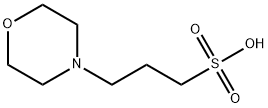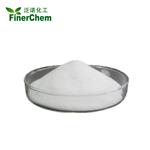MOPS (3-morpholinopropanesulfonic acid) is a buffer introduced by Good et al. in the 1960s. It is a structural analog to MES. Its chemical structure contains a morpholine ring. HEPES is a similar pH buffering compound that contains a piperazine ring. With a pKa of 7.20, MOPS is an excellent buffer for many biological systems at near-neutral pH.It is used as a synthetic buffering agent below pH 7.5.
MOPS is frequently used as a buffering agent in biology and biochemistry. It has been tested and recommended for polyacrylamide gel electrophoresis. Usage above 20 mM in mammalian cell culture work is not recommended. MOPS buffer solutions become discolored (yellow) over time, but reportedly slight discoloration does not significantly affect the buffering characteristics.
P. H. Quail, D. Marme, E. Schäfer, Particle-bound phytochrome from maize and pumpkin, Nature New Biology, 1973, vol. 245, pp. 189-191
White/clear crystalline powder
MOPS acts as a multi-purpose buffering agent used in various biological research.
Due to its inert nature, 3-morpholinopropanesulfonic acid (MOPS) is widely used as a buffer in many biochemical studies. MOPS has been used as a cell culture additive component in lentiviral particle production, a buffering agent in microbial growth medium and nuclei extraction buffer, a component of Roswell Park Memorial Institute (RPMI) medium for diluting fungal inoculum, and a buffer in capillary-zone electrophoresis to test performance. It is also used for the dilution of proteins from algal samples.
ChEBI: 3-(N-morpholino)propanesulfonic acid is a Good's buffer substance, pKa = 7.2 at 20 ℃. It is a member of morpholines, a MOPS and an organosulfonic acid. It is a conjugate acid of a 3-(N-morpholino)propanesulfonate. It is a tautomer of a 3-(N-morpholiniumyl)propanesulfonate.
3-(N-Morpholino)propane sulfonic acid (MOPS) is an N-substituted amino sulfonic acid with a morpholinic ring. MOPS is capable of buffering within a pH range of 6.5-7.9. MOPS is widely used in biological and biochemical studies due to its inert properties. It does not interact with any metal ions in solutions and has significant metal-buffer stability especially with copper (Cu), nickel (Ni), manganese (Mn), zinc (Zn), cobalt (Co) ions. MOPS buffer maintains the pH of the mammalian cell culture medium. MOPS functions to maintain pH in denaturing gel electrophoresis of RNA. MOPS can modify lipid interactions and influence the thickness and barrier properties of membranes. MOPS interacts with bovine serum albumin and stabilizes the protein. Hydrogen peroxide oxidizes MOPS slowly to N-oxide form.
Flammability and Explosibility
Not classified
Morpholine and 1,3-Propanesultone are added to absolute ethanol for reaction. The crude product synthesized is purified to obtain 3-Morpholinopropanesulfonic acid.





